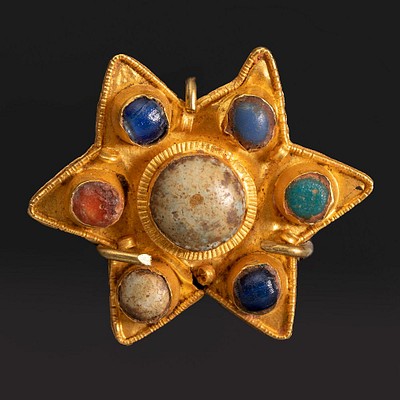ANTONIO DEL CASTILLO SAAVEDRA (Cordoba, 1616 - 1668). "Pastoral scene". Oil on canvas.
Lot 80
About Seller
Setdart Auction House
Carrer Aragó 346
Barcelona
Spain
Setdart Subastas was born in 2004 and is currently the first online art auction in Spain with solidity, prestige and reliability guaranteed by our more than 60,000 users. Setdart has a young, dynamic and enterprising team ready to successfully manage the purchase and sale of art works through custom...Read more
Estimate:
EUR€14,000 - EUR€18,000
$15,053.76 - $19,354.84
Absentee vs Live bid
Two ways to bid:
- Leave a max absentee bid and the platform will bid on your behalf up to your maximum bid during the live auction.
- Bid live during the auction and your bids will be submitted real-time to the auctioneer.
Bid Increments
| Price | Bid Increment |
|---|---|
| EUR€0 | EUR€10 |
| EUR€200 | EUR€25 |
| EUR€500 | EUR€50 |
| EUR€1,000 | EUR€100 |
| EUR€3,000 | EUR€200 |
| EUR€5,000 | EUR€500 |
| EUR€10,000 | EUR€1,000 |
| EUR€20,000 | EUR€2,000 |
| EUR€50,000 | EUR€5,000 |
About Auction
By Setdart Auction House
Dec 21, 2021
Set Reminder
2021-12-21 07:30:00
2021-12-21 07:30:00
America/New_York
Bidsquare
Bidsquare : Córdoba: 2,000 Years of Art
https://www.bidsquare.com/auctions/setdart-auction-house/c-rdoba-2-000-years-of-art-8049
Setdart Auction House sofia@setdart.com
Setdart Auction House sofia@setdart.com
- Lot Description
ANTONIO DEL CASTILLO SAAVEDRA (Cordoba, 1616 - 1668). "Pastoral scene". Oil on canvas. Period frame. Measurements: 125 x 81 cm; 135 x 93 cm (frame). We are in front of a pastoral scene close to other drawings made by Del Castillo Saavedra, today preserved in the collection of the Museum of the Academy of San Fernando, as "Study of shepherd with his flock of sheep" or "Study of hunter with peasants". The present canvas shows the figure of an elderly shepherd. The old man watches over his flock, made up mostly of sheep, although presided over by a bright white goat. Palomino praised Del Castillo Saavedra for his ability to capture nature, and described him as "an excellent landscape painter, for which he used to go out for a few days to walk, with an errand to draw, and he copied some places from nature". This note of the treatise writer shows Antonio del Castillo as a painter especially interested in the representation of nature, something evident not only in his landscapes but also in the everyday characters and animals that populate many of his works and that can be seen in the canvas we are dealing with. Antonio Castillo is the painter considered the father of the Cordovan school. He was also a polychromator and designer of architectural, decorative and goldsmith projects. He was the son of Agustín del Castillo, a little known painter from Llerena (Extremadura) whom Palomino describes as "an excellent painter". It is also believed that he may have trained as a polychromator in Calderón's workshop. However, he was orphaned when he was only ten years old, in 1626, and went on to develop his training in the workshop of another painter of whom we have no news, Ignacio Aedo Calderón. Although there is no real evidence of this, it is believed that he may have arrived in Seville, where, according to Palomino, he entered Zurbarán's workshop. This has been corroborated by the stylistic influence of the master from Extremadura that historians have seen in Castillo's work. However, in 1635 he was back in his native Cordoba, where he married and settled permanently, to finally become without discussion the most important artist of the city. His fame and quality earned him important commissions, including religious altarpieces, portraits and medium-sized series. He was also the teacher of outstanding Cordovan painters of the following generation, such as Juan de Alfaro y Gámez. Regarding his language, Antonio del Castillo did not develop an evident evolution in his work, although towards the end of his life a more softened language can be appreciated, and he kept away from the baroque novelties of other contemporary painters. However, like the rest of his contemporaries, he was seduced by the novelty of Murillo's work, and in his last years he would introduce the Venetian chromatic softness of the Sevillian master. Generally speaking, in the religious figures he remained closer to strict naturalism, while in the historical compositions he was usually more open, especially when adding architectures and landscapes to his paintings. Palomino praised his capacity for capturing nature, and described him as "an excellent landscape painter, for which he would go out for a few days to walk, with an errand to draw, and he copied some places from nature". This note by the treatise writer shows Antonio del Castillo as a painter especially interested in the depiction of nature, something evident not only in his landscapes but also in the everyday characters and animals that populate many of his works. Also, numerous drawings by his hand are preserved in which he portrays natures, characters and animals with great accuracy and immediacy. In fact, Palomino himself continues to assert that Castillo's love of drawing led him to make "drawings of whatever was offered to him". This determines a direct and truly singular work, of which today there are examples in the Prado Museum, the Hermitage in St. Petersburg, the J. Paul Getty in Los Angeles, the Louvre, the Metropolitan in New York, the Courtauld Institute in London, the Municipal Museum of Malaga and the Cathedral of Cordoba, among other collections and religious centers.
- Shipping Info
-
In-house shipping available. Please inquire at admin@setdart.com.
-
- Buyer's Premium



 EUR
EUR CAD
CAD AUD
AUD GBP
GBP MXN
MXN HKD
HKD CNY
CNY MYR
MYR SEK
SEK SGD
SGD CHF
CHF THB
THB

















